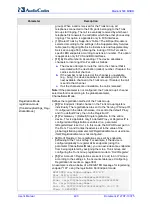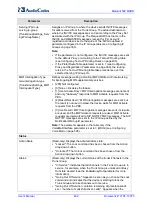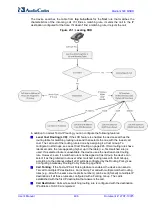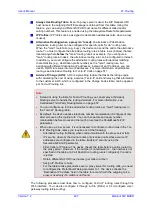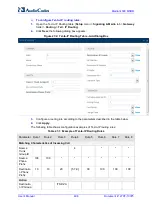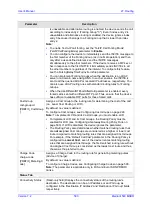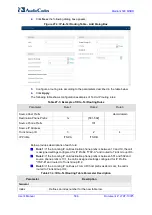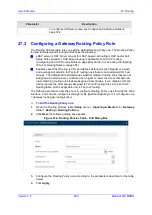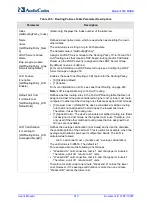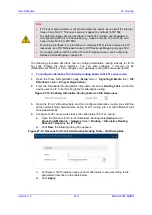
User's Manual
504
Document #: LTRT-10375
Mediant 500 MSBR
Parameter
Description
For IP Groups, the status indicates the connectivity with the SIP proxy
server's address configured for the Proxy Set that is associated with the IP
Group. For the status to be displayed, the Proxy Keep-Alive feature, which
monitors the connectivity with proxy servers per Proxy Set, must be enabled
for the Proxy Set (see Configuring Proxy Sets on page 348). If a Proxy Set is
configured with multiple proxies for redundancy, the status may change
according to the proxy server with which the device attempts to verify
connectivity. For example, if there is no response from the first configured
proxy address, the status displays "No Connectivity". However, if there is a
response from the next proxy server in the list, the status changes to "OK".
If there is connectivity with the destination, the field displays "OK" and the
device uses the routing rule if required. The routing rule is not used if any of
the following is displayed:
"n/a" = IP Group is unavailable.
"No Connectivity" = No connection with the destination (no response to
the SIP OPTIONS).
"QoS Low" = Poor Quality of Service (QoS) of the destination.
"DNS Error" = No DNS resolution. This status is applicable only when a
domain name is used (instead of an IP address).
"Not Available" = Destination is unreachable due to networking issues.
27.2 Configuring IP-to-Tel Routing Rules
The IP-to-Tel Routing table lets you configure up to 120 IP-to-Tel routing rules. IP-to-Tel
routing rules route incoming IP calls to Trunk Groups. The specific channel pertaining to
the Trunk Group to which the call is routed is determined according to the Trunk Group's
channel selection mode. The channel selection mode can be configured per Trunk Group
(see Configuring Trunk Group Settings on page 487) or for all Trunk Groups, using the
global parameter ChannelSelectMode.
Configuration of IP-to-Tel routing rules includes two areas:
Match:
Defines the characteristics of the incoming IP call (e.g., IP Group from which
the call is received).
Action:
Defines the action that is done if the incoming call matches the characteristics
of the rule (i.e., routes the call to the specified Tel/Trunk Group destination).
The device searches the table from
top to bottom
for the
first
rule that matches the
characteristics of the incoming call. If it finds a matching rule, it sends the call to the Tel
destination configured for that rule. If it doesn't find a matching rule, it rejects the call.
If an IP-to-Tel call cannot be routed to the Trunk Group, the device can route it to an
alternative destination:
Routing to an Alternative Trunk Group:
If the device sends the IP call to the Tel
destination and a subsequent call release reason (cause) code (e.g., 17 for User
Busy) is received from the Tel side, and you have configured this release reason code
in the Reasons for IP-to-Tel Alternative Routing table, the device re-routes the call to
an alternative Trunk Group if an alternative routing rule has been configured in the
table. The alternative routing rules must be configured in table rows (indices) that are
located anywhere below the "main" routing rule. For example, if you configure a "main"
routing rule in Index 4, the alternative routing rule can be configured in Index 6. In
addition, you must configure the alternative routing rules with identical matching
characteristics (e.g., destination prefix number) to the "main" routing rule, but assigned
with different destinations (i.e., Trunk Groups). For more information on IP-to-Tel
alternative routing and for configuring call release reasons for alternative routing, see
Summary of Contents for Mediant 500 MSBR
Page 2: ......
Page 33: ...Part I Getting Started with Initial Connectivity ...
Page 34: ......
Page 36: ...User s Manual 36 Document LTRT 10375 Mediant 500 MSBR This page is intentionally left blank ...
Page 40: ...User s Manual 40 Document LTRT 10375 Mediant 500 MSBR This page is intentionally left blank ...
Page 45: ...Part II Management Tools ...
Page 46: ......
Page 48: ...User s Manual 48 Document LTRT 10375 Mediant 500 MSBR This page is intentionally left blank ...
Page 115: ...Part III General System Settings ...
Page 116: ......
Page 132: ...User s Manual 132 Document LTRT 10375 Mediant 500 MSBR This page is intentionally left blank ...
Page 137: ...Part IV General VoIP Configuration ...
Page 138: ......
Page 290: ...User s Manual 290 Document LTRT 10375 Mediant 500 MSBR This page is intentionally left blank ...
Page 306: ...User s Manual 306 Document LTRT 10375 Mediant 500 MSBR This page is intentionally left blank ...
Page 380: ...User s Manual 380 Document LTRT 10375 Mediant 500 MSBR This page is intentionally left blank ...
Page 454: ...User s Manual 454 Document LTRT 10375 Mediant 500 MSBR This page is intentionallty left blank ...
Page 455: ...Part V Gateway Application ...
Page 456: ......
Page 460: ...User s Manual 460 Document LTRT 10375 Mediant 500 MSBR This page is intentionally left blank ...
Page 484: ...User s Manual 484 Document LTRT 10375 Mediant 500 MSBR This page is intentionally left blank ...
Page 494: ...User s Manual 494 Document LTRT 10375 Mediant 500 MSBR This page is intentionally left blank ...
Page 625: ...Part VI Session Border Controller Application ...
Page 626: ......
Page 654: ...User s Manual 654 Document LTRT 10375 Mediant 500 MSBR This page is intentionally left blank ...
Page 656: ...User s Manual 656 Document LTRT 10375 Mediant 500 MSBR This page is intentionally left blank ...
Page 741: ...Part VII Cloud Resilience Package ...
Page 742: ......
Page 751: ...Part VIII Data Router Configuration ...
Page 752: ......
Page 753: ......
Page 754: ......
Page 756: ...User s Manual 756 Document LTRT 10375 Mediant 500 MSBR This page is intentionally left blank ...
Page 757: ...Part IX Maintenance ...
Page 758: ......
Page 834: ...User s Manual 834 Document LTRT 10375 Mediant 500 MSBR This page is intetnionaly left blank ...
Page 837: ...Part X Status Performance Monitoring and Reporting ...
Page 838: ......
Page 848: ...User s Manual 848 Document LTRT 10375 Mediant 500 MSBR This page is intentionally left blank ...
Page 852: ...User s Manual 852 Document LTRT 10375 Mediant 500 MSBR This page is intentionally left blank ...
Page 854: ...User s Manual 854 Document LTRT 10375 Mediant 500 MSBR This page is intentionally left blank ...
Page 878: ...User s Manual 878 Document LTRT 10375 Mediant 500 MSBR This page is intentionally left blank ...
Page 880: ...User s Manual 880 Document LTRT 10375 Mediant 500 MSBR This page is intentionally left blank ...
Page 926: ...User s Manual 926 Document LTRT 10375 Mediant 500 MSBR This page is intentionally left blank ...
Page 927: ...Part XI Diagnostics ...
Page 928: ......
Page 950: ...User s Manual 950 Document LTRT 10375 Mediant 500 MSBR This page is intentionally left blank ...
Page 954: ...User s Manual 954 Document LTRT 10375 Mediant 500 MSBR This page is intentionally left blank ...
Page 956: ...User s Manual 956 Document LTRT 10375 Mediant 500 MSBR This page is intentionally left blank ...
Page 958: ...User s Manual 958 Document LTRT 10375 Mediant 500 MSBR This page is intentionally left blank ...
Page 974: ...User s Manual 974 Document LTRT 10375 Mediant 500 MSBR This page is intentionally left blank ...
Page 976: ...User s Manual 976 Document LTRT 10375 Mediant 500 MSBR This page is intentionally left blank ...
Page 977: ...Part XII Appendix ...
Page 978: ......
Page 982: ...User s Manual 982 Document LTRT 10375 Mediant 500 MSBR This page is intentionally left blank ...

